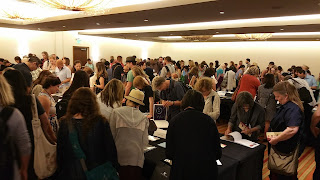I had all the spreads pinned to my wall, so I could manage the process and be aware of what was still left to do in the time frame that I had to do it in. Every time I sent a finished illustration to the publisher and they accepted it with no changes, then I could unpin that image, and could visually see my load diminishing. I don't know if you are a list maker, but checking off items on lists is a big motivator in me.
 |
| All cleaned up -- With the extra marks |
I began by cleaning up all the extra marks from around my images. See the before and after image on the left. Some prints that had a lot of details, took a long time to clean up.
After the images were cleaned, I dragged them into the same file, and converted the different layers into color. This was the fun part. Sometimes I'd spend a while tweaking things back and forth, to get just the right shade and relationship between the colors.
During the process, I had also taken the margins and gutter into consideration, and in the last steps, I would set the illustration in a template I had made, to make sure everything lined up right, and nothing important was too close to an edge to be lost. On the right you can see the above illustration, finished and laid into the template with the margins layer visible.
Everyone at the publisher's side was so great to work with. They rarely had things to change, they were fast to communicate with and they listened to the ideas I had. I really couldn't have imagined a more pleasant team of people to work with on this whole project.
Below is the last video in this series, where you can see more in detail the whole digital part of the process.
I hope you enjoyed this little series on how the book Four Otters Toboggan: An Animal Counting Book, was made. I look forwards to launching the book in March. It also coincides with World Earth Day on April 22nd. Their theme for this year is Protect Our Species - exactly what our book is about! It's a great coincidence and I hope lots of schools will be able to use our book as part of that celebration. We'll have some activity pages related to that theme ready by then.
If you know of schools or other groups who would be interested in illustrator visits, feel free to contact me.
This month I am working on promotional things: stickers, a coloring and activity book, and a kids crate. More of those to come as soon as I get them ready to show you.
Have a great New Year!
P.S.
You can see the previous posts related to this one at:
https://mirka-h.blogspot.com/2018/12/illustrating-otters-part-1.html
https://mirka-h.blogspot.com/2018/12/illustrating-otters-part-2.html
https://mirka-h.blogspot.com/2018/12/engraving-illustrations-for-otters-part.html



























